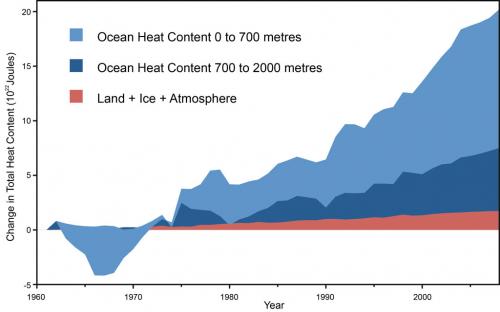

Global warming is sometimes thought of as just an increase in the air temperature, and it is a recurring myth that global warming has magically stopped whenever there is a pause in the long-term trend of increasing air temperature. However, heat is exchanged between all parts of the Earth System, and the oceans can hold vastly more heat than the air. Global warming is actually the total accumulated heat in the whole Earth System that results from the imbalance between incoming solar energy and outgoing heat and reflected energy. This figure from Nuccitelli et al. (2012) [PDF] shows the change in the total heat content of the Earth System since 1960 in terms of its major components: the total land, atmosphere, and ice heating (red) from Church et al. (2011), and the ocean heating for the 0-700 meter layer (light blue) and the 700-2,000 meter layer (dark blue) from Levitus et al. (2012).
More than 90% of global warming goes into heating the oceans, while less than 3% goes into heating the atmosphere. Even relatively small exchanges of ocean heat with the atmosphere, as occurs during the El Niño Southern Oscillation (ENSO), can produce short-term fluctuations and pauses in the increasing air temperature.
Download the data used in this figure
 |
The Skeptical Science website by Skeptical Science is licensed under a Creative Commons Attribution 3.0 Unported License. |